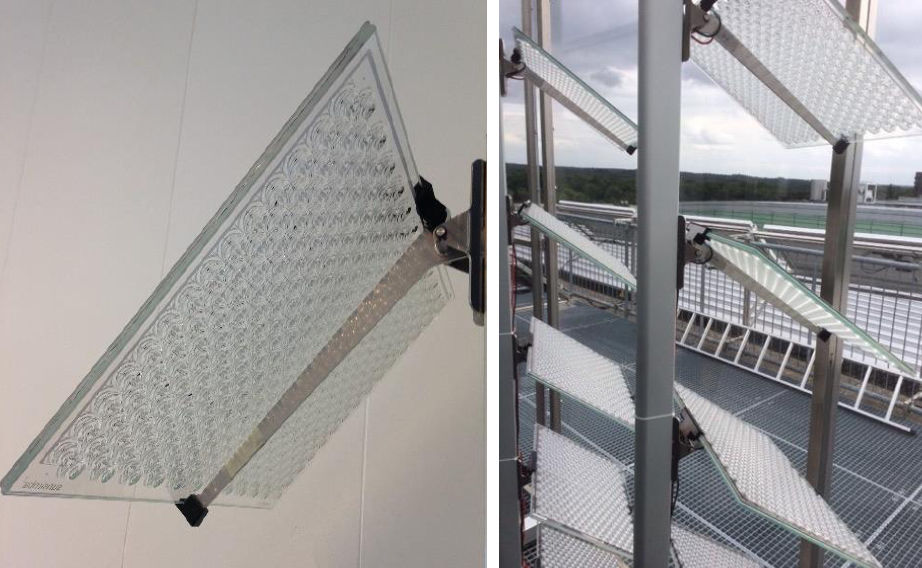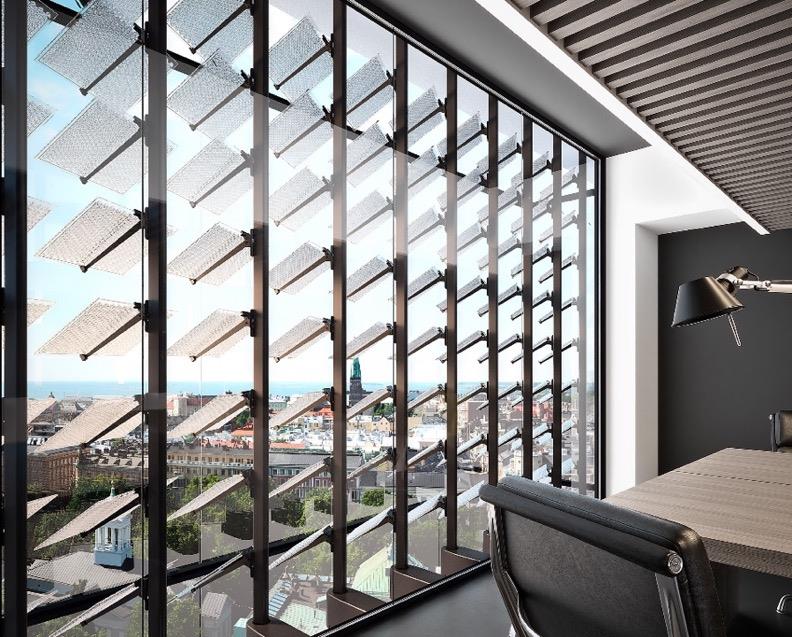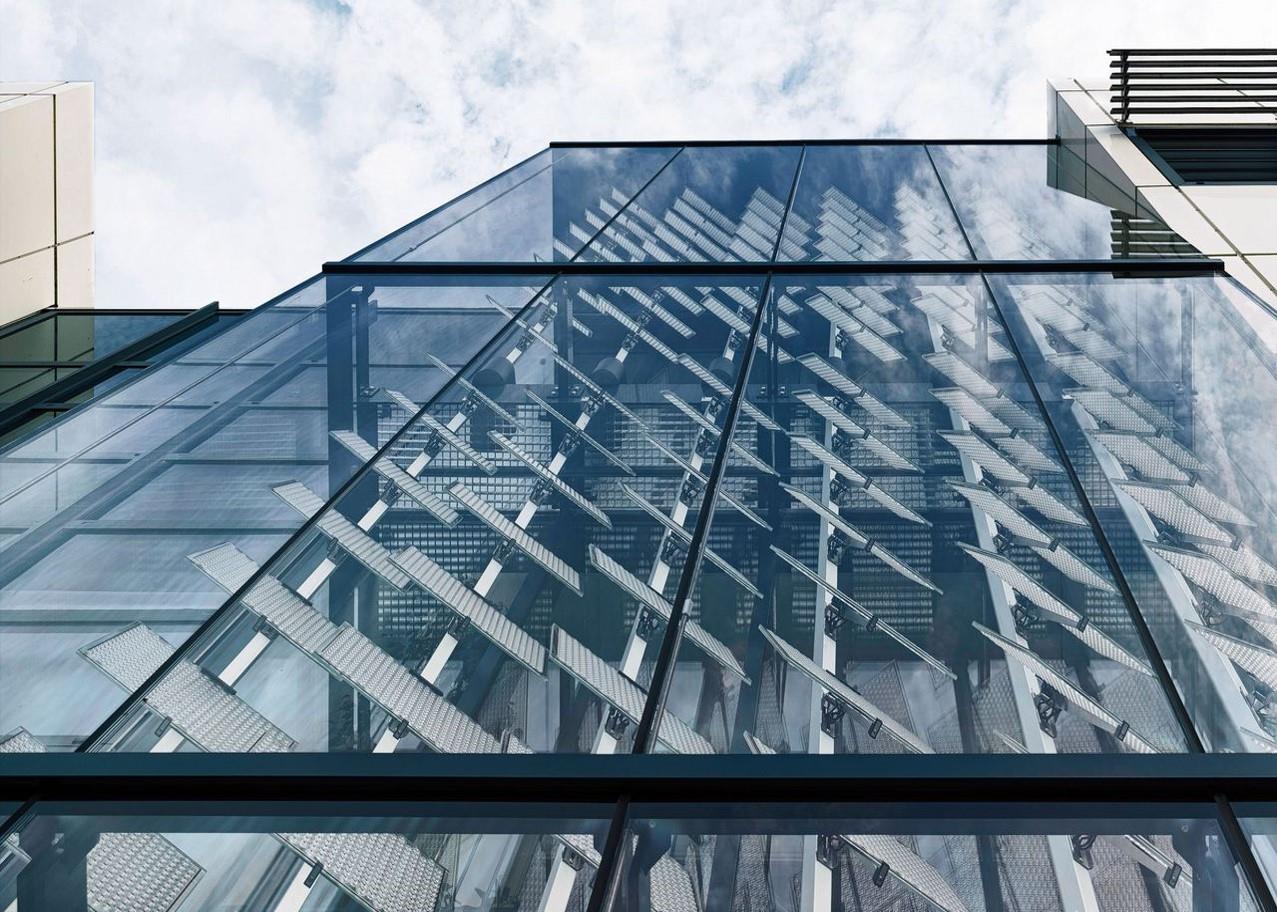Hybrid Solar Energy Systems
Prototype Systems
Lumiduct
By Antía Varela Souto and Roel Loonen, Eindhoven University of Technology, The Netherlands
Product Description
Brief Concept Description
Lumiduct is an innovative building-integrated concentrating PV (BICPV) façade system that uses an array of movable panels located in the cavity of double-skin façades to guide the incoming sunlight, so to provide shading control to glazed building façades and harvest solar energy.
The Lumiduct panels consist of special optical modules that redirect direct sunlight, and concentrate it onto tiny, ultra-high-efficiency III-V solar cells. Since the Lumiduct modules have a concentration factor above 600, the electricity generation potential per m2 façade is similar to the output of vertically mounted regular crystalline PV modules. In order to track the sun over the course of the day, the technology includes a dual-axis tracking system. An example of a single module, including the sun-tracking structure, is presented in Figure 76 (left).
This solution is developed by the company Wellsun, in close collaboration with Eindhoven University of Technology and Radboud University Nijmegen. It is currently in the technology readiness level 7, which corresponds to a demonstration system operating in an operational environment at pre-commercial scale.
Architectural and Technological Integration into the Envelope
Lumiduct is designed as a facade integrated solution, and not as separate modules to be added onto existing façades. The modules are installed into several vertical pillars, which are in turn integrated in the cavity of a doubleskin façade. Figure 76 (right) presents an example of the installation of the modules into pillars.
The Lumiduct façade system can be connected to the building’s HVAC system. In this way, the warm air in the cavity can be used to pre-condition ventilation air, thereby reducing energy demand for heating. Another possibility is to harvest heat in the cavity of the double-skin façade using an air-to-water heat exchanger, so that the extracted thermal energy can either be used for space heating, or to satisfy domestic hot water needs.

Figure 76. Lumiduct module on the left and integration of multiple modules into pillars on the right.
Integration into the Building: System and Comfort
Since Lumiduct tracks the sun over the course of the day (dual-axis tracking), the direct part of the sunlight is always absorbed while the diffuse daylight passes freely. In this way, Lumiduct acts as a selective solar shading device, addressing multiple needs at the same time. Apart from producing electricity, Lumiduct significantly reduces solar heat gains and thus the space cooling load of the building. It also functions as a glare protection system blocking the direct solar radiation, while the diffuse daylight still enters the room and reduces the need for artificial lighting. An important side-benefit of Lumiduct, compared to regular solar shading systems, is that the view to outside and an enhanced access to the many health and well-being benefits of daylight is guaranteed at all times. Figure 77 presents an artist’s impression of the indoor environment with a full-scale building integration of Lumiduct. Figure 78 shows a bottom view of a 40 m2 demonstrator façade integrating Lumiduct.

Figure 77. Artist’s impression, full-scale building integration of Lumiduct.

Figure 78. Bottom view of the demonstrator façade of the Lumiduct BICPV system.
SWOT Analysis
Strengths
- The appearance is attractive and suitable for highend architectural applications • Lumiduct offers glare protection, but admits diffuse irradiation, lowering the use of artificial lighting
- It is possible to effectively manage solar heat gains, so to reduce space cooling demand and/or lower the risk of overheating
- Green electricity is generated with high efficiencies (29% module efficiency) in a translucent configuration
- The heat losses are reduced in winter as the closed cavity acts as thermal buffer
- The view to the outside is improved thanks to the semi-transparent characteristics of the façade, compared to other shading systems
- The system is suitable for installations in multistory buildings since the dynamic components are not exposed to outside conditions (e.g. wind loads) but protected in the double skin
- The movements are smoother and the operation quieter compared to other automated façade systems
- There is no need for multiple add-on technologies as the product can simultaneously provide glare protection, daylighting and electricity production
- The façade is modular, as the modules are integrated into multiple pillars
Weaknesses
- Moving parts → There is a technical risk that could be an obstacle to investment. However, this is already a common risk, looking at an automated sun protection system. In addition, Lumiduct makes only one cycle a day and it is in a conditioned room
- The width of the cavity depends on the size of modules and sun tracking system but is relatively large. This reduces usable floor area for the same building volume (effects on value proposition)
- The upfront investment for a Lumiduct façade is high. This can be tackled with innovative business models, such as leasing, or with the Total Cost of Ownership approach
- The self-shading from modules reduces the electricity generation, but it is necessary to guarantee glare protection
- The view to the outside is compromised due to the optics compared to regular windows
- External shading from urban context influences the performance of the system.
- The increased weight on the façade due to the glazed modules can become problematic in highrise buildings and for retrofits
- The external glass reduces radiation reaching solar cells, but it is necessary for security and to reduce the maintenance of the module
- If the sky is overcast and there is a desire to maximize daylight access, new control features need to be implemented to open the façade. This results in an increased complexity of the control
Opportunity
- A strong movement towards net zero energy buildings (NZEB) supported by legal obligations is rising and it could drive the adoption of this solution
- The integration with local DC networks at a building level could be possible
- An upgrade the façade modules for higher efficiency ones is easy
- LEDs could be integrated on the modules for special light effects and publicity at night.
- New business models for façades are spreading, such as Energy Service Companies (ESCOs)
- Integration in a double-skin façade → Potential for heat collection and use in HVAC systems.
- There is potential for pre-fabrication.
- The installation in buildings where the view to the outside is not the main requirement (swimming pools etc.) is also possible
- The system assists in matching energy supply and demand, since dual-axis tracking extends the electricity production period compared to regular PV systems
Threats
- Dependency of MorganSolar for the supply of the modules, as the current commercial alternatives are inferior
- The construction sector is risk-conscious and slowly adapts to new technologies preferring existing solutions with a proven track record
- Dependency on electricity price → A reduction of electricity price can make business case weaker
- Power generation window films, blinds and shutters with PV integration represent the competition in the existing market
- The business case is partly based on ‘intangible’ values such as view and daylight
- The value proposition is multivariate → Singlefunction systems (e.g. PV or blinds systems) might outperform Lumiduct on single aspect
- Decreasing PV costs reduces competitive position
- Those who benefit from better indoor environment and lower energy bill (tenant) are not always the same entity making the capital investment decisions
- User interaction and acceptance is still to be tested
Lessons Learned
The lesson learned are summarized as follows:
- The required accuracy of the tracking system is a major challenge. A maximum deviation of 0.9 degrees for both tilt and rotational motion is allowed in order to capture direct irradiation and generate electricity. Moreover, it is required to have an accurate adjustment of the individual pillars relative to each other. Overall, this high accuracy needs to be achieved with low-cost hardware suitable for series production.
- The pillars that integrate the modules should be controlled as a collective, so the system can be integrated in a façade. A two-way communication protocol needs to be developed, to exchange information between the control and the pillars.
- Implementation of optimization measures in the circuitry of the solar cells within the modules, and between the modules and the power optimizers (maximum power point trackers) is necessary, to minimize the losses caused by self-shading of modules and shading from the surroundings.
- The dynamic characteristics and physical phenomena that take place inside the Lumiduct façade are not compatible with the range of possibilities offered in building performance simulation software. Performance prediction of Lumiduct therefore requires modification of simulation models at the source code level. This is a time-consuming task that needs to be carried out by specialists.
Further Reading
Website company Wellsun: http://www.wellsun.nl/lumiduct-design-and-sustainability.html
Submitted paper for the VIII International Congress on Architectural Envelopes (ICAE) as part of a PhD research at Eindhoven University of Technology. This publication evaluates the thermal and daylight performance of the sun-controlling dynamic façade system Lumiduct (Saini, Loonen, & Hensen, 2018).
Investigation performed by Radboud University Nijmegen (RUN) on the effect partially of shaded modules on the energy performance of the façade system, both by external elements or due to self-shading within the system
(Bunthof et al., 2016). Bunthof, L. A. A., Kreuwel, F. P. M., Kaldenhoven, A., Kin, S., Corbeek, W. H. M., Bauhuis, G. J., … Schermer, J. J. (2016). Impact of shading on a flat CPV system for façade integration. Solar Energy, 140, 162–170. https://doi.org/10.1016/j.solener.2016.11.001
Saini, H., Loonen, R. C. G. M., & Hensen, J. L. M. (2018). Simulation-based performance prediction of an energyharvesting façade system with selective daylight transmission. In VIII International Congress on Architectural Envelopes (ICAE).